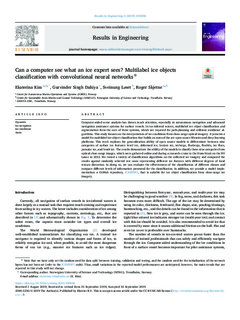| dc.contributor.author | Kim, Ekaterina | |
| dc.contributor.author | Dahiya, Gurvinder | |
| dc.contributor.author | Løset, Sveinung | |
| dc.contributor.author | Skjetne, Roger | |
| dc.date.accessioned | 2020-02-10T11:56:38Z | |
| dc.date.available | 2020-02-10T11:56:38Z | |
| dc.date.created | 2019-09-20T03:19:07Z | |
| dc.date.issued | 2019 | |
| dc.identifier.citation | Results in Engineering (RINENG). 2019, 4 1-13. | nb_NO |
| dc.identifier.issn | 2590-1230 | |
| dc.identifier.uri | http://hdl.handle.net/11250/2640680 | |
| dc.description.abstract | Computer-aided scene analysis has drawn much attention, especially in autonomous navigation and advanced navigation assistance systems for surface vessels. In ice-infested waters, multilabel ice object classification and segmentation form the core of these systems, which are required for path-planning and collision avoidance algorithms. This study focuses on the interpretation of ice conditions from close-range optical imagery. It presents a model for multilabel ice object classification that builds on state-of-the-art open source libraries and deep learning platforms. This work explores the generalization ability of open source models to differentiate between nine categories of surface ice features: level ice, deformed ice, broken ice, icebergs, floebergs, floebits, ice floes, pancake ice, and brash ice. The results demonstrate the ability of the models to classify these nine categories from optical close-range images, which were gathered online and during a research cruise to the Fram Strait on the R/V Lance in 2012. We tested a variety of classification algorithms on the collected ice imagery and compared the results against randomly selected test cases representing different ice features with different degrees of local texture distortion. In doing so, we can evaluate the effectiveness of the classification of different classes and compare different levels of information presented for the classification. In addition, we provide a model implementation: a GitHub repository, ICEXPERT, that is suitable for ice object classification from close-range ice imagery. | nb_NO |
| dc.language.iso | eng | nb_NO |
| dc.publisher | Elsevier | nb_NO |
| dc.relation.uri | https://www.sciencedirect.com/science/article/pii/S2590123019300362?via%3Dihub | |
| dc.rights | Attribution-NonCommercial-NoDerivatives 4.0 Internasjonal | * |
| dc.rights.uri | http://creativecommons.org/licenses/by-nc-nd/4.0/deed.no | * |
| dc.title | Can a computer see what an ice expert sees? Multilabel ice objects classification with convolutional neural networks | nb_NO |
| dc.type | Journal article | nb_NO |
| dc.type | Peer reviewed | nb_NO |
| dc.description.version | publishedVersion | nb_NO |
| dc.source.pagenumber | 1-13 | nb_NO |
| dc.source.volume | 4 | nb_NO |
| dc.source.journal | Results in Engineering (RINENG) | nb_NO |
| dc.identifier.doi | 10.1016/j.rineng.2019.100036 | |
| dc.identifier.cristin | 1726994 | |
| dc.description.localcode | This article is available under the Creative Commons CC-BY-NC-ND license and permits non-commercial use of the work as published, without adaptation or alteration provided the work is fully attributed. | nb_NO |
| cristin.unitcode | 194,64,20,0 | |
| cristin.unitcode | 194,64,91,0 | |
| cristin.unitname | Institutt for marin teknikk | |
| cristin.unitname | Institutt for bygg- og miljøteknikk | |
| cristin.ispublished | true | |
| cristin.fulltext | original | |
| cristin.qualitycode | 1 | |

